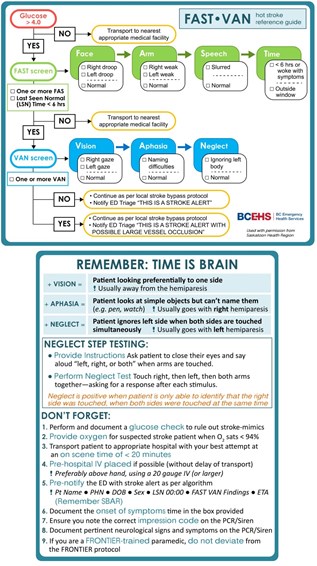Confirmation
Stroke Care
November 15, 2019
*Note:
We want your feedback on how this podcast helps you in your profession and/or how it could be improved. Please take moment to complete this survey: https://ubc.ca1.qualtrics.com/jfe/form/SV_0fwj7lOJ5raw8rr
Hosts:
Gordon Minaker, Primary Care Paramedic and Medical Student with the UBC Medical Program
Kaela Richardson, Respiratory Therapist and Medical Student with the UBC Medical Program
Guests:
Kevin Lambert, Critical Care Paramedic, Lead Instructor of Critical Care Paramedic Education at BC Emergency Health Services
Date of Episode Release:
November 14, 2019
Episode Description:
In this episode, we describe the basic pathophysiology of stroke and its mechanisms of injury, detailing the two major types of stroke. Examples of common clinical presentations and use of the FAST-VAN assessment is discussed, and how to identify stroke mimics. Lastly, we discuss the concept of the “hot stroke,” and timelines for different types of treatment.
Points to Remember:
Stroke Definition
- Sudden non-traumatic vascular insult resulting in a lack of blood flow to the brain
- May be caused by a clot (ischemic) or spontaneous bleeding (haemorrhagic)
Goal of Care:
- Identify reversible conditions
- Timely scene managements
- Transport and hospital notification
FAST-VAN Algorithm

Stroke Mimics
- Hypoglycemia
- Head bobbing (seen more in children)
- Seizure disorder, including post-ictal state
- Alcohol, illicit substances
- Metabolic disturbances
"Hot Stroke" and Timelines
Definition: Hyperacute stroke symptoms with onset less than 6 hours ago.
Ischemic stroke treatments in hospital include:
- < 4.5hrs - IV recombinant tissue plasminogen activator (tPA)
- 4.5-6hrs - Endovascular thrombectomy
- 6-24hrs - Endovascular thrombectomy *case-by-case basis
References:
Stroke Guidelines - BCEHS Handbook
https://handbook.bcehs.ca/treatment-guidelines/adult-guidelines/altered-mental-status/stroke//
FAST-VAN Stroke Guideline - BCEHS Handbook
https://handbook.bcehs.ca/clinical/checklists-reference/stroke-neurological/fast-van-stroke-guide/
FAST-VAN Stroke Bypass Protocol for Vancouver Island South - BCEHS Handbook
BC Stroke Care Centre Tiers - BCEHS Handbook
https://umbraco.bcas.ca/media/1429/bc-stroke-care-tiers-of-service-model-nov-2017.pdf
Hosseininezhad M, Sohrabnejad R. Stroke mimics in patients with clinical signs of stroke. Caspian J Intern Med. 2017;8(3):213–216. doi:10.22088/cjim.8.3.213
https://www.ncbi.nlm.nih.gov/pmc/articles/PMC5596193/
Oliveira MD. Initial assessment and management of acute stroke. Post TW, ed. UpToDate. Waltham, MA: UpToDate Inc. https://www.uptodate.com (Accessed on November 1, 2019.)
Have an idea for a podcast episode? Know someone that would make an awesome guest? Please take a moment to email us directly.
Email: podcast@bcehs.ca